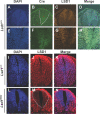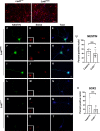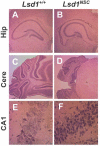This is a preprint.
LSD1/KDM1A is essential for neural stem cell differentiation in mice
- PMID: 38076951
- PMCID: PMC10705553
- DOI: 10.1101/2023.12.02.569711
LSD1/KDM1A is essential for neural stem cell differentiation in mice
Abstract
The proper regulation of neural stem cell differentiation is required for the proper specification of the central nervous system. Here we investigated the function of the H3K4me1/2 demethylase LSD1/KDM1A during neural stem differentiation in mice. Conditional deletion of LSD1 in nestin- positive neural stem cells results in 100% perinatal lethality after birth with severe motor coordination deficits, retarded growth and defects in brain morphology. Despite these severe defects, motor neuron progenitors and the initial motor neuron population are specified normally and motor neurons with normal morphology can be cultured from these mice in vitro. However, motor neurons cultured from mice lacking LSD1 in neural stem cells continue to inappropriately maintain critical neural stem cell proteins. Taken together these results suggest that, as in other mouse stem cell populations, LSD1 is required to deactivate the stem cell program to enable normal neural stem cell differentiation. However, unlike in other mouse stem cell populations, the inappropriate maintenance of the stem cell program during neural stem cell differentiation may compromise neuronal function rather than neuronal specification.
Figures





References
-
- Fallini C., Zhang H., Su Y., Silani V., Singer R. H., Rossoll W., & Bassell G. J. (2011). The survival of motor neuron (SMN) protein interacts with the mRNA-binding protein HuD and regulates localization of poly(A) mRNA in primary motor neuron axons. J Neurosci, 31(10), 3914–3925. 10.1523/JNEUROSCI.3631-10.2011 - DOI - PMC - PubMed
Publication types
Grants and funding
LinkOut - more resources
Full Text Sources
